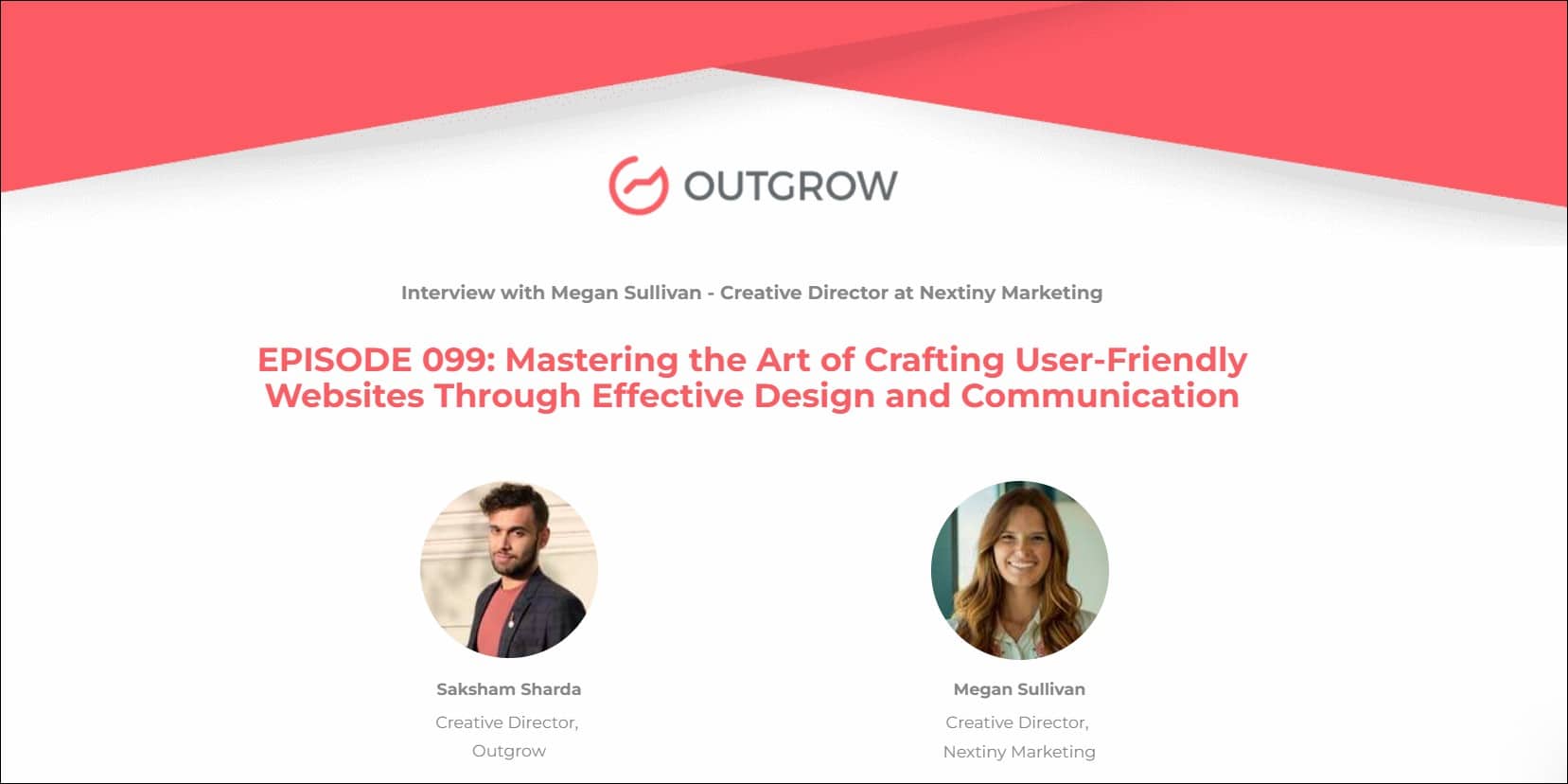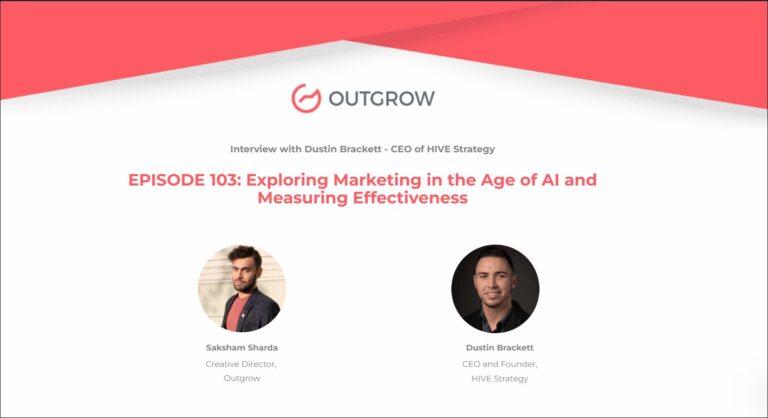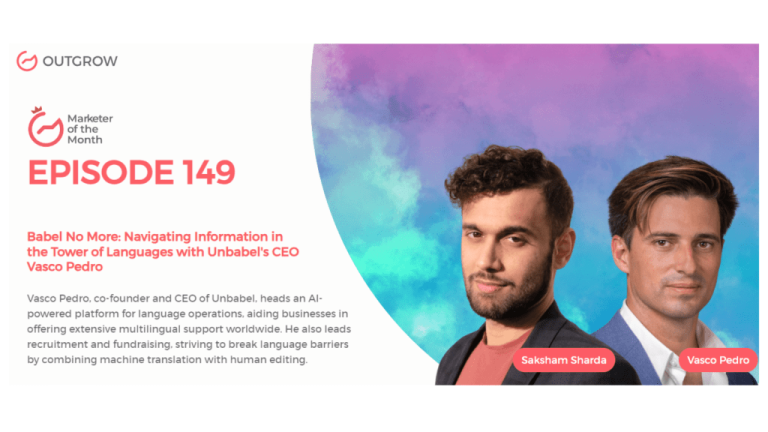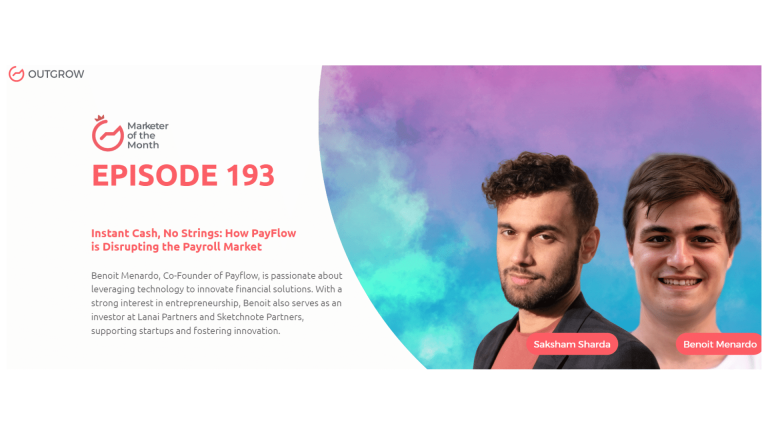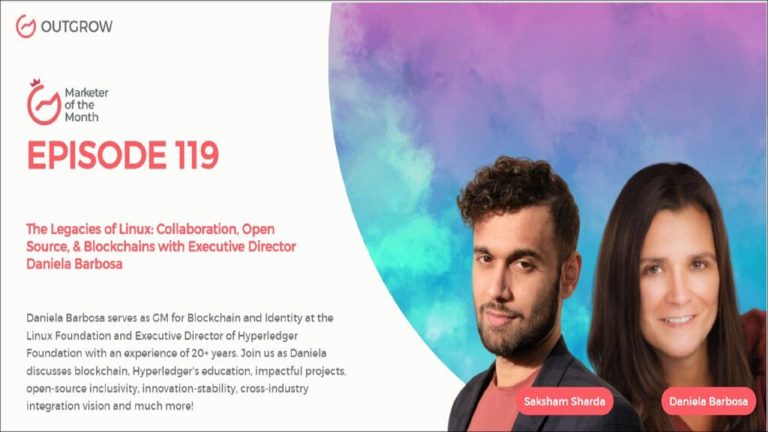EPISODE 099: Marketer of the Month Podcast with Megan Sullivan
Table of Contents
Hey there! Welcome to the Marketer Of The Month blog!
We recently interviewed Megan Sullivan for our monthly podcast – ‘Marketer of the Month’! We had some amazing insightful conversations with Megan and here’s what we discussed about –
1. The importance of research, planning, and site structure in creating effective and user-friendly websites
2. Website optimization with the help of Hubspot CMS and data analysis tools like Moz
3. Using the story brand methodology to structure a webpage and simplify marketing guesswork
4. Creating visually aligned content that communicates the client’s brand story and character
5. Handling client feedback and making design decisions that improve brand communication
6. Focusing on pages with conversions, heat mapping, and regular inventory of website performance
About our host:
Dr. Saksham Sharda is the Chief Information Officer at Outgrow.co He specializes in data collection, analysis, filtering, and transfer by the means of widgets and applets. Interactive, cultural, and trending widgets designed by him have been featured on TrendHunter, Alibaba, ProductHunt, New York Marketing Association, FactoryBerlin, Digimarcon Silicon Valley, and at The European Affiliate Summit.
About our guest:
Megan Sullivan is a talented and driven Creative Director at Nextiny Marketing, a leading digital marketing agency that helps businesses of all sizes achieve their marketing goals. Megan’s journey toward her current role started at Lee University in Cleveland, where she discovered her passion for combining creativity and business in the world of marketing. With more than half a decade of building CMS websites – Megan is an expert at understanding and visualizing messaging and branding and her keen understanding of the power of strategic marketing has helped numerous businesses in driving growth.
EPISODE 099: Mastering the Art of Crafting User-Friendly Websites Through Effective Design and Communication
The Intro!
Saksham Sharda: Hi, everyone. Welcome to another episode of Outgrow’s Marketer of the Month. I’m your host, Dr. Saksham Sharda. I’m the creative director at Outgrow.co And for this month we’re going to interview Megan Sullivan who is the Creative Director at Nextiny Marketing. Thanks for joining us, Megan.
Megan Sullivan: Thanks so much for having me. Excited to be here.
Don’t have time to read? No problem, just watch the Podcast!
Or you can just listen to it on Spotify!
The Rapid Fire Round!
Saksham Sharda: So Megan, we’re going to start with a rapid-fire round just to break the ice. In case you don’t want to answer the question, you can just say pass, but try to keep your answers to one word or one sentence only. Okay?
Megan Sullivan: All right
Saksham Sharda: So the first one at what age do you want to retire?
Megan Sullivan: 40
Saksham Sharda: How long does it take you to get ready in the mornings?
Megan Sullivan: 10 minutes
Saksham Sharda: The most embarrassing moment of your life?
Megan Sullivan: Falling in front of a bunch of people when accepting an award
Saksham Sharda: Your favorite color?
Megan Sullivan: Orange
Saksham Sharda: At what time of the day are you most inspired?
Megan Sullivan: Mornings
Saksham Sharda: How many hours of sleep can you survive on?
Megan Sullivan: Six.
Saksham Sharda: Fill in the blank- An upcoming marketing trend is ___________.
Megan Sullivan: An upcoming marketing trend is chatGPT, curious to see what that comes up in
Saksham Sharda: The city in which the best kiss of your life happened?
Megan Sullivan: Florida.
Saksham Sharda: Pick one – Mark Zuckerberg or Jack Dorsey?
Megan Sullivan: Jack Dorsey.
Saksham Sharda: The biggest mistake of your career?
Megan Sullivan: I’m sending out emails that were misspelled to a lot of people.
Saksham Sharda: How do you relax?
Megan Sullivan: Bubble bath
Saksham Sharda: How many cups of coffee do you drink per day?
Megan Sullivan: One
Saksham Sharda: A habit of yours that you hate?
Megan Sullivan: Being on my phone too much
Saksham Sharda: The most valuable skill you’ve learned in life?
Megan Sullivan: Resilience and treating people with kindness.
Saksham Sharda: And the last one is your favorite Netflix show.
Megan Sullivan: Right now, “Survivor”.
Saksham Sharda: Okay. All right. Well, that was the end of the rapid-fire round.
The Big Questions!
Saksham Sharda: So now we can go on to the bigger questions and you can answer them with as much ease as you’d like. So no pressure here.
Megan Sullivan: Okay.
Saksham Sharda: So can you tell us about your experience of working in HubSpot CMS and building CMS websites? How do you ensure that the CMS website is user-friendly and easy to navigate for both the client and end users?
Megan Sullivan: Yes, I love this question. I started with the agency I’m working with now a little over six years ago and pretty much started right in with building websites and working within the HubSpot CMS. So have a little over six years of experience, specifically in the CMS platform. Really big fan of how easy it is and intuitive is for users to use as well as the security and a ton of factors why we love the platform. Getting user experience, right? It’s something I’m really passionate about. And creating a really clean website that communicates is something that you know, that’s the whole meat and potatoes of things. But I think that setting the structure for your site and getting that clear on who specifically needs to be spoken to on the site. What is the journey we want to send them on is a big piece for a sort of making it user-friendly if we know who we’re talking to, we know how to talk to them, and how to sort of navigate them on the site. So that’s a piece we do a lot of research beforehand, a lot of planning and preparation. When discovering site when discovering how we’re putting a site together, as well as obviously thinking through best practices that we know from data and research of what’s going to make the most sense, we don’t have more than seven items or eight items on our main navigation and we try to avoid dropdowns and there’s a bunch of little tactical pieces that go into that but getting your structure right. And obviously, using the HubSpot CMS to make a site that pretty communicates goes a long way when it comes to user experience for sure.
Saksham Sharda: Do you feel the websites are getting simpler and simpler as we go into the future or more and more complicated?
Megan Sullivan: I would say in some ways simpler. Like I think if you look at a lot of websites, now you’re seeing you know people are having simple easy navigations with few pages and honestly not super content-heavy sites. But in the same way, there are a lot of advanced things you can do with your sites like creating smart content. So communicating specific language and communicating specific messaging on sites to someone who’s viewing the site from one place, or to someone who’s coming to the site from Google or PayPal, etc. So it’s getting complex in some ways, but in a lot of ways, I would say sites are good, sites are leaning towards being more simple, being more straightforward, having less copy being easier to read, you know, not having these massive mega menus. And I think that’s a good positive change for us as users as well as for companies who are taking advantage of that.
Saksham Sharda: So could you relate this to the story brand methodology? And how can one use it to structure a web page?
Megan Sullivan: So story brand, if anyone out there is not familiar is, it comes heavily from Donald Miller and his book, I think it’s called the starboard methodology. And he talks all about this concept of the story and how we see it in entertainment and films and these common themes of, you know, there’s a character who has a problem. And then they need a guide who helps them overcome this problem. And there’s this common theme that we as humans are drawn to for entertainment and that we’ve seen over and over again, throughout all of history. And what Donald Miller did is he said, “Hey, how can we use this engaging framework that seems to be a part of like the makeup of who we are, we’re drawn to it, to use that in our marketing, to tell better stories to create marketing that connects with customers”. I like to think of it as the difference between kind of talking at your ideal buyer personas versus talking to them and engaging them in conversation. So it’s a cool methodology that if you can master to create this story, the whole book in the framework takes you through a guide for your company putting together who is your character, who is your ideal persona, what’s the problem, they have both philosophical and practical, you know, and then you are their guide. So you’re not the hero of the story. This is the meat and potatoes of where we see this playing out. In businesses, a lot of times businesses like to put themselves as the hero even, you see that on website pages from the H1, where it’s like, owned and operated since X, Y, and Z, or, you know, We Are the World Class XY and Z, which might be great information, but it’s not what I want to know, right? When I’m coming to your site, I want to know, how your service or solution solves a problem that I’m trying to solve. And so it’s the difference between positioning yourself as like, “hey, we can help you become the hero, we can help you get your marketing, right, we can help you, build your dream home or whatever it may be, and making them the hero and you are just helping them along the way”. And if you can get this sort of framework and this messaging right, it can make all the difference in how you are communicating to and with your clients by speaking like actually adding them in with them. Instead of sort of over their heads, or not hitting the nail on the head of connecting and engaging. So it’s a super cool way that simplifies a lot of the guesswork of if you can get your framework right, it simplifies a lot of this. Well, what do we put on the homepage? How do we can kind of, from every page on your site, or landing page or campaign, you can kind of follow this simple structure of, okay, let’s introduce who we are. And then let’s tell the customer, we understand their problem, etc. There’s a seven or eight-part framework that they lay out how to even structure your homepage, specifically on your site. So it’s a really powerful tool that you can even use in any aspect of your marketing. So one example of an email, I just recently was talking about this with someone and had an email in my inbox. And it was two different companies trying to sell me a rug. And one of the companies was like, you know, super rug warehouse sale. Now somebody like that. And the other company was like, check out you deserve a new rug, or your house deserves a new ride or something like that. And it was like this messaging that was like, “oh, yeah, like I do deserve a new rug. Let me check it out”. And it’s the difference between, you know, speaking directly to your customers into their needs, versus sort of talking about yourself or presenting yourself as the hero of your story where you create this kind of like, well, I’m automatically going to identify myself as the hero of my story. So when you are also the hero, it kind of creates this tension between like, well, let me try to get the best deal out of you or let me try to you know, but when you can present yourself as the guide who has authority in the space to solve a problem. It’s really easy to kind of walk ideal customers through this journey, so yeah, can go on and on about it. But it’s something we’re passionate about. And that creates simplifies getting messaging right on your site, and honestly, all of your marketing efforts.
Saksham Sharda: So keeping all this in mind, how do you specifically approach creating visual content that aligns with the client’s brand and messaging?
Megan Sullivan: Yeah, this is another great question and a fun thing to talk to with a fellow creative. It’s always a fun challenge to work within a company’s brand. We don’t have a ton of my agency, specifically branding. So typically, a company comes to us already with some brand standards established. And then it’s really fun to go through this process of discovering what is your brand story, what is the character we’re trying to talk to get a really clear understanding of that, and then try to communicate that visually through the story, but also through really clear and stunningly creative, that’s easy to connect with. And a lot of that does playback on that sort of initial story of coming up with this plotline and then producing images or graphics, or visual displays that align with that. Another thing that we tried to do is have smiling faces on sites that have people as humans, connect with other humans, we connect with people who are successfully experiencing our product or service. So that’s something, that’s a story brand piece that plays out visually in a lot of our sites. But, just getting a really clear understanding of who the brand identity is also exploring some of their competitors, how they have done it, and how can we do it better. How can we communicate better, and then sort of trying to make that into obviously, a stunning website that does the job of speaking to its users, as well as converting and you know, ultimately getting more business for the company is what we’re after? Right? So it’s a fun and challenging task. But one that we like to be up for the challenge for?
Saksham Sharda: And how do you go about doing this competitive research in the first place?
Megan Sullivan: Yeah, I think a lot of it is, obviously there’s some SEO research that goes into this piece, and a lot of it is also so we look at competitor analysis from a technical SEO standpoint, who’s ranking better than them for keywords they’re wanting to rank for, and then take a look at how their site setup. So maybe we can take some cues from their specific site structure. Then also, a lot of times, we have a kickoff questionnaire. So our projects or website projects with our clients start with this big initial sort of discovery piece where we take them through the questionnaire and get an understanding of how are we going to tell this story. And in that piece of part of that is they say, “Okay, here’s who we are constantly losing out to business to for one reason, or another, or here’s who is outperforming us or who’s competitors in your area”. So we do some of that research on r&d in the back end, just through some SEO, some Moz, some Google Analytics, etc. And as well as using the HubSpot platform. And then also we rely on our competitors to let us know, “Hey, these are people who we feel our inner industry who are performing strongly that we want to sort of pull cues from as well as we always have them, send us over”. Hey, send us some examples of sites you like and things that you think companies who you think are getting it right. And then we take some cues from that as well. So if someone’s doing something well, and something’s performing well, we don’t necessarily always need to restructure that foundation. But we can take some cues from that and incorporate them into what might make sense for our site structure, etc.
Saksham Sharda: So taking into account everything you’ve said to now, what would you say are the three things that every successful website must have?
Megan Sullivan: Yeah, I would say, number one is a clear and clean structure. I cannot tell you how many times people come to us saying like, “yeah, we only have like 10 pages on our site, we just did a new site”. And we do a crawl of the site. And we discover thousands and thousands of pages that they don’t even know about that are out there somewhere ranking. So having a clear structure that makes sense for your users’ journey. There’s so much that goes into it, but having a clear structure, having clear messaging, and I’m going to kind of cheat by baking SEO into that. So with all the test technical SEO pieces in there in mind, thinking through, you know, what is this need to communicate clearly to tell the digit, to tell the user story. And also, how can we get the technical SEO pieces right in here so that we’re using the right language and telling the right story for what our users are searching? So if you have a stunning site that tells all the right messages, but you don’t have that SEO piece in place. It’s not always saying, “Well, no one’s going to find your site. So that’s a really important piece for us as well. And then lastly, having calls to action or having some sort of place on your site where a visitor can convert or do business with you or download your guide, interact with your brand in such a way that you can continue to nurture them, is going to be a big game changer. That’s one of the things I recommend as such a quick win for anyone listening who doesn’t have this on their site already but creating sort of that clear call to action. That’s the first step of doing business with you. So let’s say maybe that’s scheduled a call or booking a demo, or requesting a quote, or whatever that first step your sales team takes to engage with the client, maybe it’s by now if your e-commerce creating that clear call to action in the top right and center of your site is something that we do just off the bat on any of our site projects. And it’s insane the difference that just making it easy reducing calories for me as a user to go in and say, “oh, okay, I know where to get started. I don’t have to go digging for it”. I don’t have to waste energy on my end, Knowing how to just do business with you is something that is such a quick win but a call to action in general having some sort of lead nurturing on your site is going to be another success that I think every website that’s doing well performing well and generating leads needs for sure.
Saksham Sharda: So do you have examples of websites that are doing well in one of these three spheres? Or a website that is doing well in all three of these fears? Any popular website you can think of
Megan Sullivan: I might have to think through that and send you over some of all the sites that we build selfishly, I think do that well. But then I think that HubSpot does a decently good job. The story brand website does a really good job of following the story brand methodology with all of these pieces. And then yeah, I’ll have to think as far as popular websites, if there’s anything that comes to mind for it that piece
Saksham Sharda: One thing that I’ve noticed is just websites getting simpler and simpler and more minimalistic and more minimalistic. But they have thought through all these three things as well, while at the same time being minimalistic. So I was thinking of the Tesla website, for instance quite good at doing that. So on and so forth. Yeah?
Megan Sullivan: Yeah, that’s a great example. Yeah, a lot of it’s cool to see a lot of companies moving that way. Because I know that’s what I want to see, as a user, I want you to make my life easier when I get to your site. With fewer options, I don’t want to be overwhelmed with all the places I have to go on your site, I want to be clear, you know, I know who I am, I know what I’m looking for and I’m looking to buy a Tesla for X, Y, and Z. And I know exactly where to go. And I don’t have to read a ton to figure out how to get there. So it’s I’ve been excited to see that trend become more and more popular on sites as a whole.
Saksham Sharda: So speaking of trends, how do you stay updated on industry trends and advancements and data-driven design and user experience?
Megan Sullivan: Yeah, so I’m a part of a ton of groups, we have the privilege of helping to lead the CMS for the marketers’ study group and office hours alongside HubSpot. So we are part of a group of marketers who are doing, you know, what we’re talking about right now building sites, building campaign assets. So being a part of a ton of those kinds of groups, we’re always going to training. So we’ve done the store-brand training multiple times. I think connecting with people who are doing it, and then also obviously, learning from some industry trends, and keeping up with some different news articles, etc. is always helpful. But talking to people who are actually doing it and have the numbers for their clients or have specific results is one way that I always love to do and then just see what’s out there. And I’m so keenly aware, because this is what I’m doing every day, every time I get on the site, or navigate. Just in my personal life. I’m always taking notes of this is interesting. You know, like you’re saying, Tesla, if you’re on a site, like some something like that, and you’re just very aware of what they’re doing. So yeah, connecting with other marketers, other people in the industry who are doing the things, connecting with groups who you can learn from like store brand, or HubSpot, these huge companies who are always putting out new data and information about best practices that they have access to from hosting millions and millions of sites, etc. As well as you know, connecting with people, people in the industry and just keeping your eyes out for the latest and greatest.
Saksham Sharda: And what are you doing to match the current trend there are some companies whose websites remained the same for 10 years and one fine day, they realize, “oh, they look quite ancient”. But the other companies are constantly changing the interface, and this annoys users sometimes as well because they’re used to the lifestyle. So where do you think the balance is?
Megan Sullivan: Yeah, I do. I would agree it’s a fine balance. I would say that the websites that we build and how we like to approach websites internally and how I think is the smartest way to approach websites is kind of this growth-driven design model where it’s not a print campaign, you know, it’s not something you’re saying into print, and you’re not going to touch for another x years, especially if you are hosting your site on a platform where you have data, which a lot of the site hosting platforms, now you have access to a ton of data. What we like to do is set a site live. And, anytime you’re doing something like that, you’re making changes on your site, there’s some sort of guesswork that you have to take, at least in the beginning, when making some of those decisions, even about your user journey, or your ideal buyer persona, you can do as much research as possible. But at the end of the day, you have to make a decision and set it live. And then what we love to do is use research and data that you can see even, you know, heat mapping through tools like the orange and hot jar, to see how users are experiencing the site, how users are interacting with the site, and then making small iterations from there, not overhauling. So every time I go to the homepage of your site, it’s a completely new menu with completely new XY and Z. But you know, every six months at least taking inventory of hey, what’s working well on the site and what’s maybe not working well, and then making small iterations as you learn from real life users data. And as your sales team is talking to customers who are interacting with your site, what are they saying? What are the pieces that they’re looking for, that they’re not able to easily find on your site? Once you have that data, it’s like pure gold, it’s difficult to shift through because there is so much of it, and so much you can do with it. But using that to sort of have this growth-driven design approach where you’re slowly making iterations, every six months doing an inventory and saying, “Hey, what pages do we need to maybe optimize?” What can we change about color schemes, etc, to continue to grow this site? And, depending on the size and the scale of the company, you might be able to do that more often. But I think at a minimum every six months to a year a small midsize company should be taking a look at the data they have for their site, and seeing how they can iterate to improve the site based on how users are using it.
Saksham Sharda: So for our interested audience members, could you walk us through a specific project where you utilize data to improve the user experience?
Megan Sullivan: For sure. So we do this all the time. We do it specifically at the beginning of a site where we go through a sort of that inventory. And we do a ton of data to see what well, first of all, we crawl the whole site. So we make sure we have a really clear understanding of exactly what lives and exists on your site, which I would recommend anyone doing at any point there, we’ve screamed for all of us Screaming Frog. If you use HubSpot, you can actually obviously see a list of all of your entire sites hosted in HubSpot, you can see a ton of great data about all of your HubSpot pages, but starting with some sort of inventory of what exists on your site. So you know what pages are out there? How they’re performing to at least some degree. And then from there, obviously, we make decisions based on conversations of users for you know what that means, site structure should be. But once you have a site live, and you’re looking at data to see how should we iterate? Or how should we optimize the site to improve or match user experience, user experience? A simple way to start is to look at page views, look at pages, looking at page bounce rates. So seeing how many people are going navigating to a specific page? Is the bounce rate high on that page? Is that because they’re finding the information that they wanted to find on that page quickly? Or is that because maybe the name of the page or the way they got to that page, or the experience they were expecting to have on that page is not what they’re having on that page? Looking at some of that data, looking at some of the keywords, how did they get to that page? And then saying, okay, maybe we can make iterations to if a lot of people if a lot of traffic is navigating their way through this page through to this page on our site. And the bounce rates are high. So they’re maybe not finding the information they want to find. What were they expecting to find on this page? Because so many people got there and wanted to see something X, Y, and Z? How can we optimize or make this page make more sense? For the traffic that’s getting there? How can we update the content? Or how can we maybe remove this page altogether and create a different experience for the one that makes sense for us also? I think the easiest way if you’re looking to do this, just from the get-go, is to look at your top viewed pages. So the top 5-10 viewed pages on your site. Does that make sense for your business for your company? Does that make sense as far as page content, what is what lives what exists on those pages? Looking at how users are getting there, how can you maybe take a lot of eyeballs that are getting on a specific page, but optimize the page content to make more sense for users on the page? Also, adding a call to action you can do tests on like what I recommend is having that main call to action across the board on your entire site, and what we see a lot of people doing with me and calls to action are changing them. So what on the top right corner, let me have let’s chat in the front center of their site, they’ll have scheduled a visit, you know, in the bottom, they’ll have to get started. And what I would recommend, and a simple thing you can do right now to test or optimize your site is to keep that main call to action, the language, the color, and the styling of the button itself consistent, every single place that it lives across your entire site. And then a couple of reasons for that your brain needs to see something eight times before it registers it. So you want to reinforce that. And you’re also not wasting as many calories for me when I’m saying, What’s the difference between let’s chat and schedule a visit or let’s chat and get started? And I’m not sure which button to click on. So if you have these calls to action, number one, I would recommend just right off the bat, keeping them all consistent. And then number two, doing some data switching up the messaging maybe every five months to let’s chat to schedule a call and seeing which of those calls to action is getting you more leads more conversions, more click-through rates, etc. Focusing on the pages that you do have conversions on starting there to do some optimizations on how many people are converting. If not a lot of people aren’t converting. How can we make this message clearer or stronger? So people do want to convert our top viewed pages. Do they have some sort of conversion on them? So is there a place if a ton of people are going to this specific blog because it has really good SEO? Are we sending them somewhere from there, so just sort of mining through the crazy amounts of data that you can get within a site there’s a ton more you can get into with heat mapping? So you can use tools like I mentioned Lucky Orange or hot jar to see where a user is navigating on the site. So it’ll show you a heat map of where their mouse is scanning. A lot of times we see people trying to click on things that the functionality within the site is not built to have a clickable feature there. So a simple change in that front would just be hey, let’s make this click somewhere, or let’s make it feel less like it should be able to be clicked. So there’s sort of a mass amount. But a good place to start is looking at your top viewed pages, looking at your conversion pages. And looking at the data how can we make small iterations to this to see if we can see improvements, test it for a while and then iterate again?
Saksham Sharda: So it’s a particularly challenging project you have managed like this, and how did you overcome any obstacles during that process?
Megan Sullivan: Overcome any obstacles when sort of optimizing sites? Yeah, I would say, I’m just making time on the calendar to do it, especially if you’re a business owner, or just a marketer who this o part of our job. So it’s something we’re doing proactively all the time. But if it’s something that it’s so easy like you said to have a site and just set it and forget it and have it for five, six years, never touch it, never look at the data. So making time to take inventory of how your site is performing, or how your client’s site is performing. You know, every six months, every year at least doing a deep dive into this makes sense. OMoreoften, I would recommend reviewing your site for SEO. So even you can set up alerts if you have Moz. Or if you have HubSpot do the SEO scans. So I would say the biggest challenge f see for most people trying to do this is just actually setting aside time on the calendar to make it happen. So that I would say be the number one thing and then number two, don’t overcomplicate it, you know, it doesn’t have to be this whole, like you said site redesign or a complete overhaul of your site, every time you’re wanting to sort of update or make enhancements to your site, you can start small, you can start with making one or two iterations every month. And then eventually, obviously, your site’s gonna take on this whole new look and feel. So start with your most impactful pages, your top viewed pages, your conversion pages, the pages you want to matter, and have the most bang for your buck on your site and make the time to look at the data and make the changes. And I think it can go a long way for people who are hosting and managing and creating content on sites. It’s specifically
Saksham Sharda: So coming to the client side of things. How do you handle client feedback and make revisions to visual content?
Megan Sullivan: Yeah, this again is always a fun and delicate balance because when creating a site you want to create something that the client is proud of that they are excited about that feels like it fits their specific vision and, you know, creative direction. But also there’s obviously expertise. And there is sometimes design dissent or disagreement between maybe our agency or me specifically and the client, where they want to head with a specific design direction. And I think having done this enough, there’s enough that I know of, you know, you’re paying us, for me, I’m the marketing team that they’re paying to work with to create a really clear site that communicates well. So there’s some leverage there when saying, “hey, maybe we would make this decision because of XY and Z. Usually, when a client has a differing opinion or wants to see something a specific way, visually, what I’ll do is I’ll show them both options, and nine times out of 10, when they see one option, compared to another option, that we can kind of lead them that way by giving them what they want, and then showing them maybe a better way to do it. It’s sort of the least abrasive way. And then also, we have the benefit of having built so many, probably, I think the agency close to 500 sites at this point that we have a ton of data to pull from. So some of the decisions are just design decisions that don’t make a big impact at the end of the day, should it be blue, or should it be green? Some of these are not going to be made or broken. But obviously, some of those decisions can be any sort of we it’s our job to decide when and where to provide some of that pushback and say, “Hey, because of data, we maybe would recommend your h1 or this being structured a little differently, or the messaging being a little different.” And we have some data to back us up for why we would make that specific decision, whether it be content or design or structure, etc. But yeah, usually, if it’s a specific just design decision, that’s not going to make a big impact. On any other piece, I’ll try to show them both options, and steer them in a direction that I think is going to be a little bit more modern and date and visually appealing, for sure. But those are fun conversations to navigate through, it’s always a fun challenge to be able to work within different brands, and sort of bring something creative to the table, that’s going to make the brand and the customer happy. And also, you know, feel like we’re doing a good job of elevating who they are and how they’re communicating as a brand.
Saksham Sharda: So I suppose you have a lot of templates from which you can give choices to the clients who don’t agree with a particular style.
Megan Sullivan: Yes, yeah, we do. We have a template library that we work with, specifically actually, which we do for a ton of different reasons, but it makes some of those kinds of decisions a little easier for sure.
Saksham Sharda: Alright, so the last question for you is of a personal kind. It is, what would you be doing in your life right now if not this?
Megan Sullivan: A great question. Fun fact, I’m a little over seven months pregnant right now, so yeah, so that’s exciting. So I think, if not for this, looking into the future, I’m excited as a creative about real estate I would love to be hosting, or managing rental properties. Would be something that I would be excited to do in the future. And obviously, all of the marketing tools in your table go into all of that. But what I’m most excited about in the future, which I’ll still be doing this, but alongside this, is just growing and building a family and having a baby. So, yeah, something along the lines of real estate or managing real estate. There are so many creative ways to be making money even online. So really interested and inspired by people who are doing that successfully through, a ton of different avenues. So yeah, I’m excited for what’s to come. I’m excited to be in this wheelhouse cuz I think it goes a long way for any other area of business or world you might find yourself in. But I think if I wasn’t doing this, I’d love to be, um, designing and managing Airbnbs.
Saksham Sharda: That’s interesting because we also did some research, our team did some research and they found that if you had all the time in the world somewhere on the internet it says you’ll buy a sailboat and go sailing.
Megan Sullivan: Yes.
Saksham Sharda: You said that somewhere.
Megan Sullivan: That’s true. If money was no option and I could be doing absolutely anything. I would live in Florida right by the water. So that would probably be my dream. Life would just be to be able to just sail and spend time outdoors with loved ones.
Let’s Conclude!
Saksham Sharda: Alright, well that was the last question. Thanks, everyone for joining us for this month’s episode of Outgrow’s Marketer of the Month. That was Megan Sullivan, who is the creative director at Nextiny Marketing. Thanks for joining us, Megan.
Megan Sullivan: Thanks so much for having me. It was a blast.
Saksham Sharda: Check out their website for more details and we’ll see you next month once again with another marketer of the month.

